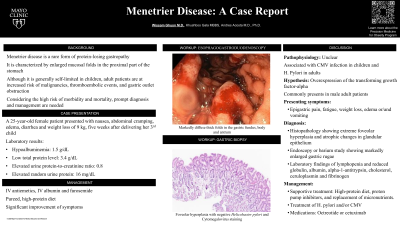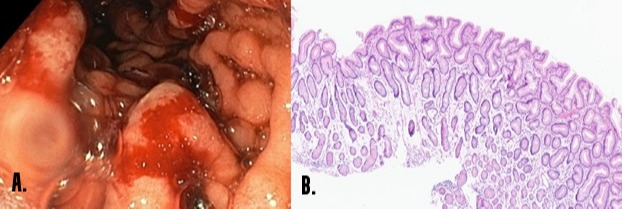Back


Poster Session D - Tuesday Morning
Category: Stomach
D0729 - Menetrier Disease: A Case Report
Tuesday, October 25, 2022
10:00 AM – 12:00 PM ET
Location: Crown Ballroom

Has Audio

Wissam Ghusn, MD
Mayo Clinic
Rochester, MN
Presenting Author(s)
Wissam Ghusn, MD, Khushboo S. Gala, MD, Andres Acosta, MD, PhD
Mayo Clinic, Rochester, MN
Introduction: Menetrier disease is a rare form of protein-losing gastropathy that is characterized by enlarged mucosal folds in the proximal part of the stomach. Although it is generally self-limited in children, adult patients are at increased risk of malignancies, thromboembolic phenomenon, and gastric outlet obstruction. Considering the high risk of morbidity and mortality, prompt diagnosis and management are needed. We present a rare case of Menetrier disease, occurring in a postpartum female patient.
Case Description/Methods: A 25-year-old female patient presented with nausea and abdominal cramping, diarrhea and weight loss of 9 kg five weeks after delivering her 3rd child. These symptoms were followed by anasarca. Her laboratory tests showed hypoalbuminemia of 1.5 g/dl, low total protein level of 3.4 g/dl, elevated urine protein-to-creatinine ratio of 0.8, and elevated random urine protein of 16 mg/dl with otherwise normal labs (e.g., complete blood count, comprehensive metabolic panel). An esophagogastroduodenoscopy revealed markedly diffuse thick folds in the gastric fundus, body and antrum (Image 1A). Antral mucosa and antral-fundic transition zone mucosa showed foveolar
hyperplasia with negative Helicobacter pylori and cytomegalovirus (CMV) staining (Image 1B). She was treated with IV antiemetics, IV albumin and furosemide and started on a pureed, high-protein diet which resulted in a significant improvement in her symptoms.
Discussion: Although the pathophysiology of Menetrier disease is unclear, it has been associated with CMV infection in children and H. Pylori in adults. One hypothesis contributes the etiopathogenesis to an overexpression of the transforming growth factor-alpha. It commonly presents in male adult patients with epigastric pain, fatigue, weight loss, edema or/and vomiting. The diagnosis can be made based on histopathology showing extreme foveolar hyperplasia and atrophic changes in glandular epithelium. Moreover, endoscopy or barium study showing markedly enlarged gastric rugae along with laboratory findings of lymphopenia and reduced globulin, albumin, alpha-1-antitrypsin, cholesterol, ceruloplasmin and fibrinogen levels are indicative of this disease. Supportive treatment involves high-protein diet, proton pump inhibitors, and replacement of micronutrients. Treatment of H. pylori, CMV, and medications like octreotide or cetuximab showed improvement in disease progression in some patients.

Disclosures:
Wissam Ghusn, MD, Khushboo S. Gala, MD, Andres Acosta, MD, PhD. D0729 - Menetrier Disease: A Case Report, ACG 2022 Annual Scientific Meeting Abstracts. Charlotte, NC: American College of Gastroenterology.
Mayo Clinic, Rochester, MN
Introduction: Menetrier disease is a rare form of protein-losing gastropathy that is characterized by enlarged mucosal folds in the proximal part of the stomach. Although it is generally self-limited in children, adult patients are at increased risk of malignancies, thromboembolic phenomenon, and gastric outlet obstruction. Considering the high risk of morbidity and mortality, prompt diagnosis and management are needed. We present a rare case of Menetrier disease, occurring in a postpartum female patient.
Case Description/Methods: A 25-year-old female patient presented with nausea and abdominal cramping, diarrhea and weight loss of 9 kg five weeks after delivering her 3rd child. These symptoms were followed by anasarca. Her laboratory tests showed hypoalbuminemia of 1.5 g/dl, low total protein level of 3.4 g/dl, elevated urine protein-to-creatinine ratio of 0.8, and elevated random urine protein of 16 mg/dl with otherwise normal labs (e.g., complete blood count, comprehensive metabolic panel). An esophagogastroduodenoscopy revealed markedly diffuse thick folds in the gastric fundus, body and antrum (Image 1A). Antral mucosa and antral-fundic transition zone mucosa showed foveolar
hyperplasia with negative Helicobacter pylori and cytomegalovirus (CMV) staining (Image 1B). She was treated with IV antiemetics, IV albumin and furosemide and started on a pureed, high-protein diet which resulted in a significant improvement in her symptoms.
Discussion: Although the pathophysiology of Menetrier disease is unclear, it has been associated with CMV infection in children and H. Pylori in adults. One hypothesis contributes the etiopathogenesis to an overexpression of the transforming growth factor-alpha. It commonly presents in male adult patients with epigastric pain, fatigue, weight loss, edema or/and vomiting. The diagnosis can be made based on histopathology showing extreme foveolar hyperplasia and atrophic changes in glandular epithelium. Moreover, endoscopy or barium study showing markedly enlarged gastric rugae along with laboratory findings of lymphopenia and reduced globulin, albumin, alpha-1-antitrypsin, cholesterol, ceruloplasmin and fibrinogen levels are indicative of this disease. Supportive treatment involves high-protein diet, proton pump inhibitors, and replacement of micronutrients. Treatment of H. pylori, CMV, and medications like octreotide or cetuximab showed improvement in disease progression in some patients.

Figure: Image 1: Marked enlarged gastric rugae on endoscopy (A) and foveolar hyperplasia on biopsy (B).
Disclosures:
Wissam Ghusn indicated no relevant financial relationships.
Khushboo Gala indicated no relevant financial relationships.
Andres Acosta: Gila Therapeutics – Consultant, Intellectual Property/Patents, Owner/Ownership Interest. Phenomix Sciences – Intellectual Property/Patents, Owner/Ownership Interest.
Wissam Ghusn, MD, Khushboo S. Gala, MD, Andres Acosta, MD, PhD. D0729 - Menetrier Disease: A Case Report, ACG 2022 Annual Scientific Meeting Abstracts. Charlotte, NC: American College of Gastroenterology.
